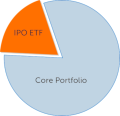After outperforming in 2023, the Renaissance IPO Index (IPOUSA) has fallen behind the S&P 500 so far this year. The IPO market is more robust than at any point since 2021, and improving returns have coaxed more large issuers to target listings.
So what's driving the gap? Mega-cap tech stocks.
Year to date, the IPO Index is up 5.8%, trailing major benchmarks like the S&P 500 (+15.5%), Russell 3000 (+13.6%), and the Nasdaq Composite (+18.0%). The biggest driver for these indices has been strong performance from mega-cap tech names, particularly trillion-dollar chipmaker NVIDIA, which has soared more than 160% since the start of the year. Other top holdings in these indices include tech heavyweights Microsoft (+22% YTD), Apple (+13%), Amazon (+24%), and Meta (+47%).
To a lesser extent, the Renaissance IPO Index has benefitted from rallies in certain large-cap tech names, including 2023 IPO Arm (+114% YTD). However, the IPO Index largely trades closer to other popular stock indices that don't have exposure to the Magnificent 7, such as the mid-cap S&P 400 (+5.0%), small-cap Russell 2000 (+0.4%), and Dow Jones Industrial Average (+3.8%).
While the IPO Index is tech-heavy and mostly weighted toward large-cap stocks, its universe of constituents is by design very different from major benchmarks. The emphasis on new stocks results in relatively smaller growth names that position the IPO Index to perform well in periods of technological advancement and strong risk appetite. It also provides for diversification beyond the Magnificent 7 and other large, well-established companies that are staples of major benchmark indices. As a result, there is typically very little overlap between the IPO Index and the major benchmarks.
The Renaissance IPO Index is the underlying index for the Renaissance IPO ETF (NYSE: IPO).


